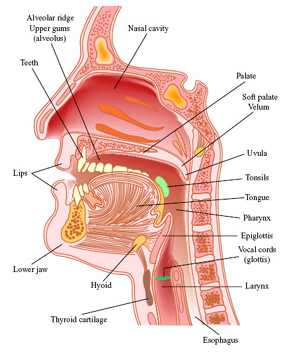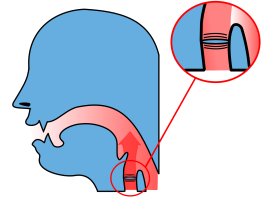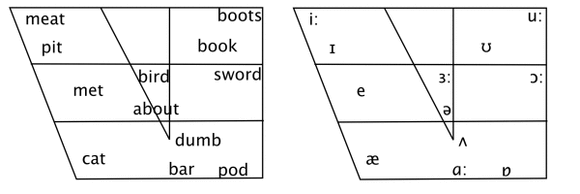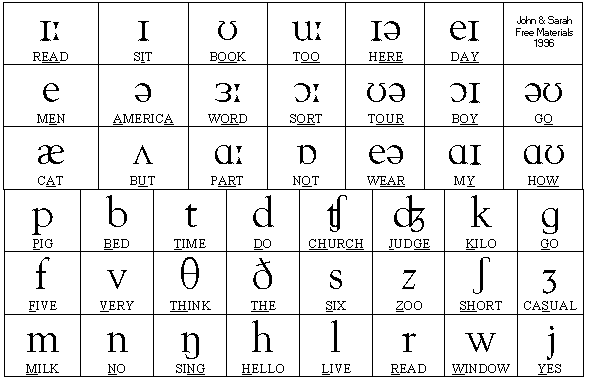by Heidrun Dorgeloh
The two primary linguistic disciplines
concerned with speech sounds - those sounds that are used by humans to
communicate - are phonetics and phonology. Both areas are mutually
dependent. Phonetics describes the concrete, physical form of sounds (how they are produced, heard and how they can be described), while phonology is concerned with the function of sounds, that is with their status and inventory in any given language.
Phones and Phonetics
The two basic tasks of phonetics are the
transcription and the
classification of sounds, also called
phones in
this context. The phone is therefore the basic unit of phonetics and it
refers to the concrete sound substance as such. In the area of
articulatory phonetics this substance is described on the basis of the articulatory properties. These refer to the human
vocal tract (or to the speech organs), illustrated below, and are used to describe and classify sounds. By contrast,
acoustic and
auditory phonetics deal with the characteristics of sound waves and how they are perceived by the human ear.
Phones
are represented by placing brackets around the transcription
([da:ns]/[dæns] for dance in British and American English)). The
usefulness of a transcription system
(a phonetic alphabet) is particularly plausible in a language such as
English, where pronounciation and and spelling often diverge
substantially (cp. see – sea on the one hand, and through and though, on
the other). There are various transcription models, such as the IPA
(International Phonetic Alphabet); for the transcription of English,
several, slightly differing systems have evolved, all of them following
in some way the original model of the phonetician Daniel Jones.
Classification of sounds
Traditionally, sounds are classified into
consonants and
vowels.
Consonants
are sounds that are produced with a major obstruction in the mouth
cavity. For example, in the case of [t] (Fig. 1), there is direct
contact between the tip of the tongue (active articulator) and the
alveolar ridge (passive articulator), so that the airflow coming from
the lungs can leave the mouth cavity only when the obstruction is
removed:
Vowels are
sounds that are produced without such obstruction. For example, in the
case of [i:] (Fig. 2), there is a gap within the mouth that is
determined by the position of the tongue, and the airflow can escape
relatively freely:
Fig. 2. vowel [i]
Another
difference between consonants and vowels is that vowels are generally
voiced, i.e. the vocal cords are set vibrating by the outgoing airflow.
Consonants, by contrast, can be voiced or voiceless: The vocal cords are
either far apart and do not vibrate, as in fan, or they are relatively closed and vibrate as in van (Fig. 3).
Fig. 3. Vibration of vocal cords in the articulation of voiced sounds
Classification of consonants
Factors relevant for the classification of consonants include the manner of articulation, the place of articulation, and voicing. With regard to the manner of articulation, English consonants can be classified into plosives, fricatives, affricates, nasals, liquids, and semi-vowels.
Plosives are consonants that are made up by completely blocking the airflow. The production of plosives involves three stages:
- a direct contact between the active and the passive articulator forming a complete obstruction to the airflow;
- the compression of air behind the obstruction; and
- the release of the compressed air in the form of an “explosion” (hence the term plosive).
There are six plosives in English: bilabial [p] and [b], alveolar [t] and [d], and velar [k] and [g].
Bilabial plosives
[p] and [b] are produced with both lips pressed together. The active
articulator is the lower lip; the passive articulator is the upper lip.
The soft palate is raised and the air coming into the mouth stops for
some time and then breaks the obstruction with a slight explosion. In
the case of [b], the vocal cords are vibrating
Fig. 4. bilabial posives [p] and [b]
Alveolar plosives
[t] and [d] are produced with the tip of the tongue firmly pressed
against the (middle part of the) alveolar ridge. The active articulator
is the tip of the tongue; the passive articulator is the alveolar ridge.
The tip of the tongue makes firm contact with the alveolar ridge. The
air is trapped for a short time and then breaks the obstruction with a
slight explosion. In the case of [d], the vocal cords are vibrating:
Fig. 5. alveolar plosives [t] and [d]
Velar plosives
[k] and [g] are articulated with the back of the tongue against the
soft palate. The active articulator is the back of the tongue; the
passive articulator is the soft palate. The back of the tongue makes
firm contact with the soft palate. The air is trapped for a short time
and then breaks the obstruction with a slight explosion. In the case of
[g], the vocal cords are vibrating:
Fig. 6. velar plosives [k] and [g]
Fricatives are
consonants that are produced by impeding, but not completely blocking
the airflow, i.e., there is a narrow gap between the active and the
passive articulator along which the airflow can leave the oral cavity.
There are nine fricatives in English: labio-dental [f] and [v], interdental [θ] and [ð], alveolar [s] and [z], palate-alveolar [ʃ] and [ʒ], and glottal [h].
Fig. 7. labio-dental fricatives [f] and [v]
The
lower lip is very close to the edge of the upper front teeth, thus
forming an incomplete obstruction. When the air goes through the
narrowing it causes slight friction (hence the term fricative).
For [f] the vocal cords do not vibrate; there may be some vibration
accompanying [v] when it occurs in word initial position as in e.g. vast or between vowels as in e.g. never.
Fig. 8. interdental fricatives [θ] and [ð]
The
tip of the tongue is either close to the edge of the upper teeth or
slightly projected between the teeth. For [θ] the friction is as strong
as for [f], for [ð] it is gentler. For [θ] the vocal cords do not
vibrate; they vibrate for [ð] when it occurs in word initial position,
before a vowel or in intervocalic positions. E.g. that, rather, etc.
Other fricatives are produced with different
places of articulation: For the alveolar fricatives [s] and [z], the tip
of the tongue is close to the alveolar ridge. The teeth are very close
together. The friction for [s] is strong, even stronger than for [θ].
For [s] the vocal cords do not vibrate; they vibrate for [z] when it
occurs before vowels or in intervocalic positions. E.g. zone, easy, etc.
Fig. 9. alveolar and palate-alveolar fricatives [s], [z], [ʃ] and [ʒ]
For
[ʃ] and [ʒ], the tip of the tongue is close to the back part of the
alveolar ridge forming a flat narrowing. The front part of the tongue is
raised towards the hard palate forming the front secondary focus. The
friction for [ʃ] is strong, stronger than for [f] and [θ]. For [ʃ] the
vocal cords do not vibrate; they vibrate for [ʒ] when it occurs before
vowels. E.g. pleasure, etc.
Fig. 10. glottal fricative [h]
It
is produced with the voiceless expulsion of air from the lungs with the
mouth and tongue already in position for the following vowel.
Affricates are
sounds that are similar to both plosives and fricatives: The tip of the
tongue touches the back part of the teeth ridge, the front part of the
tongue is raised towards the hard palate. The air is trapped for a short
time because of a complete obstruction between the tip of the tongue
and the teeth ridge, then the obstruction is released slowly and the
friction is heard. The voiceless affricate is [tʃ] as in chain, whereas [dʒ], as in jelly, is voiced.
Nasals are consonants which,
like plosives, are produced by completely blocking the airstream. But
there is an important difference: The airflow escapes through the nasal
cavity (hence the term nasals). There are three nasal consonants in English: bilabial [m], alveolar [n], and velar [ŋ]:
Fig. 11. bilabial nasal [m]
The
lips are firmly kept together forming the complete obstruction. The
active articulator is the lower lip; the passive articulator is the
upper lip. The soft palate is lowered and the air escapes through the
nasal cavity. The vocal cords are vibrating.
Fig. 12. alveolar nasal [n]
The
tip of the tongue is pressed against the alveolar ridge forming the
complete obstruction. The active articulator is the tip of the tongue,
and the passive articulator is the alveolar ridge. The soft palate is
lowered and the air escapes through the nasal cavity. The vocal cords
are vibrating.
Fig. 13. velar nasal [ŋ]
The
back of the tongue is pressed to the soft palate forming the complete
obstruction. The active articulator is the back of the tongue, and the
passive articulator is the soft palate. The soft palate is lowered and
the air escapes through the nasal cavity. The vocal cords are vibrating.
Liquids include alveolar [l] and post-alveolar [r].
Fig. 14. alveolar [l]
The
tip of the tongue is in firm contact with the alveolar ridge forming
the complete obstruction. The active articulator is the tip of the
tongue, and the passive articulator is the alveolar ridge. The sides of
the tongue are lowered and the air can pass between them. The vocal
cords are brought together and are vibrating.
Fig. 15. post-alveolar [r]
![Post-alveolar [r] Post-alveolar [r]](http://www.phil-fak.uni-duesseldorf.de/uploads/pics/14_post_alveolar_r.png)
The
tip of the tongue is held in a position near to but not touching the
back part of the alveolar ridge. The soft palate is raised and the air
flows quietly between the tip of the tongue and the hard palate. The
front part of the tongue is low and the back is rather high so that the
tongue has a curved shape. The vocal cords are vibrating.
Semi-glides or glides include bilabial [w] and palatal [j]: [w], as in why,
starts out with the lips firmly rounded, these articulators then moving
away (= gliding) from the narrowing in the mouth. When articulating
[j], as in you, the front part
of the tongue is first raised towards the hard palate, then the soft
palate is raised and the air goes along the central part of the tongue.
The vocal cords are kept together and are vibrating.
The reason why these sounds are called
semi-vowels is thus their manner of articulation: Like true vowels,
semi-vowels are produced without a major obstruction, i.e., there is a
wide gap between the active and the passive articulator, so that the
airflow can escape relatively freely from the mouth. However, unlike
true vowels, semi-vowels never form the nucleus of a syllable (e.g., week, yellow) and are therefore usually considered consonants.
Classification of vowels
Depending on the height of the tongue, vowels can be classified into
high,
low, and
mid vowels:
- When the front or the back of the tongue is raised towards the roof of the mouth, the vowel is called high, this is the case, e.g., in pill, meet, look, or soon.
- When the front or the back of the tongue is as low as possible, the vowel is called low, as, e.g., in land, star, or dog.
- When the tongue occupies the position intermediate between the high and the low one, the vowel is called mid, e.g. in get, or the unstressed [ə] in about.
Depending on the active articulator, vowels are classified into
front,
back, and
central vowels:
- When the front part of the tongue is raised towards the hard palate, the vowel is called front, e.g. in meet, get, or land.
- When the back part of the tongue is raised towards the soft palate, the vowel is called back, as in star, dog, law, or soon.
- When the front part of the tongue is raised towards the back part of the hard palate, the vowel is called central, e.g. in about, much, or nurse.
These high-low and front-back dimensions of vowel articulation are also referred to as vowel
quality. To illustrate how the articulatory properties of vowels relate to each other, a
vowel chart
is commonly used as a reference system. The chart below (adapted from
Kortmann (2006: 68)) describes the basic vowel qualities of most
standard varieties of English together with their phonetic
transcription.
As can be seen from this chart, some vowels do not only differ qualitatively, but also quantitatively (as indicated by the colon as the diacritic for length). Long as opposed to short vowels also differ by being tense as opposed to lax:
- Tense vowels
are produced with a deliberate, accurate, maximally distinct gesture
that involves considerable muscular effort. Tense vowels are either long vowels (e.g. [i:] in meet) or diphthongs (e.g. [eI] in say).
- Non-tense (or lax) vowels are produced rapidly and are therefore short (e.g. [I] in pill).
Diphthongs
The vowels described so far have all been
monophthongs, in contrast to the diphthongs (or gliding vowels), during
the production of which the tongue moves from one position to another.
Examples are in day, fight, and oil and so and sow for the so-called closing diphthongs, while centring diphthongs occur, for example, in bare, beer, and sure.
Phonemes and phonology
Phonemes, in contrast to phones, are defined by their function within the language system (langue). This function is basically one of meaning differentiation, although other functions of phonic means, such as an expressive function of vowel lengthening (That was coooooool), are also possible. All sounds, however, which have a meaning-differentiating function within a given language are considered phonemes within
that language system; these are abstract, idealized units within our
minds or parts of our model of a language that we design; in language
use (parole) phonemes are always realized as phones.
The test for these smallest distinctive units of a given language system is the minimal pair test, i.e. when a difference in sound structure also causes a shift in meaning. An example is [k] in cable and [t] in table, which therefore constitute phonemes of
English, indicated by the notation /k/ and /t/. Note, however, that we
are dealing with the actual sound structure here, not with spelling, so tea/he are a minimal pair, while see/sea are not. Also, minimal pairs are only pairings that differ in exactly one segment; so, pin and tin, or tin and ten, are minimal pairs, while pin and ten would be not.
Allophones
Some sound differences do not differentiate meaning, as in the
pronunciation of /l/ in the words lip and pill. While the difference may
be only slight (you may try to keep track of where you place the tip of
your tongue), from a phonetic point of view the two realizations of /l/
have to be considered two phones, but not two phonemes. They are called
clear and
dark /l/ and are two
allophones of the phoneme /l/ in English.
Distribution of allophones
In contrast to phonemes, allophones do not
occur in minimal pairs, which means they either never occur in the same
environment (complementary distribution), as in the case of clear and dark /l/, or they occur in free variation. For example, voiceless plosives at the end of a syllable or word are sometimes aspirated (if deep is pronounced [di:ph]), but they may just as well not be (if deep is
pronounced [di:p]). The decisive difference between phonemes and their
allophones is that the variants of a phoneme do not differentiate
meaning, and therefore the sound difference does not constitute a
relevant phonetic feature.
Phonological systems
The phonology of a language is also the inventory of its phonemes,
i.e. the sum of all those sounds that show distinctive (i.e.
meaning-differentiating) phonetic differences. RP as the standard
(British)
English sound system, for example, has
- 24 consonants,
- 12 vowels, and
- 8 diphthongs
but it has many more allophones (such as clear and dark /l/, or the aspirated plosives). By contrast,
this table
shows the phoneme inventory of Standard Mandarin, the official language
of China: As can be seen, one major difference to English is that
Standard Mandarin
lacks the voiced bilabial, alveolar and velar plosives /b/, /d/ and
/g/, while it has the aspirated versions of the consonants pʰ, tʰ, kʰ as
distinct phonemes. In other words, a difference (aspiration) that does
not distinguish meaning in English and is thus a
redundant articulatory feature constitutes a
distinctive feature
in Mandarin Chinese, while another one (the voicing of plosives) is
distinctive in English (i.e. it distinguishes meaning), but not in
Chinese.
Syllables
Phonology does not only describe a system of
sounds in isolation, but it also deals with the rules and restrictions
that hold for their combinations. This branch of phonology is called phonotactics. Phones combine into the syllable, which is essentially a vowel with optional consonants clustered around it. The vowel forms the nucleus of
a syllable, with the onset in front of it and the coda behind it.
Depending on whether there is a coda or not, a syllable can be described
as either closed or open. The basic form of the English syllable is (CCC) V (CCCC), i.e. I, spray, or texts are all examples of one syllable but of different complexity.
Prosody
Prosody belongs to the domain of suprasegmental
phonology in that it describes phenomena extending over more than one
phoneme. The phenomena that belong here are stress, rhythm, and
intonation. While stress can be word or sentence stress, rhythm and intonation occur in phrases and sentences. Intonation is described by reference to pitch (tones);
different levels of pitch are used to express a wide range of meanings:
for example, we use the difference between a falling and a rising pitch
pattern in statements and questions.
Connected Speech
The phonological changes that occur when
language is used in natural utterances are described as features of
connected speech. The most important ones are:
- assimilation, i.e. when neighbouring sounds become more alike (as in IM-possible, in contrast to IN-decent)
- elision, i.e. the loss of sounds (as in Chris(t)mas or san(d)wich)
- intrusion and linking (as in law(r) and order).
The most important feature of connected speech, however, is the occurrence of weak forms, which is the result of the occurrence of stress in connected speech. English has the property of being a stress-timed
language, which means there is a tendency for stressed syllables to
occur at fairly equal intervals. As a result, in unstressed syllables
vowel quality tends to be weakened, mostly to the schwa [ə], but the total omission of vowels (as it frequently happens in contractions, such as isn’t, she’s) is also possible, particularly in the case of function words (auxiliaries, pronouns, prepositions, conjunctions).









 are
are


![Consonant [t] Depiction of the articulation of the consonant [t]](http://www.phil-fak.uni-duesseldorf.de/uploads/pics/2_s.png)
![Vowel [i:] Depiction of the airflow in the articulation of the vowel [i:]](http://www.phil-fak.uni-duesseldorf.de/uploads/pics/vowels_web.png)

![Plosives [p] and [b] Depiction of the obstruction in the articulation of the plosives [p] and [b]](http://www.phil-fak.uni-duesseldorf.de/uploads/pics/4_h_s_01.png)
![Alveolar plosives [t] and [d] Depiction of the obstruction involved in the articulation of the alveolar plosives [t] and [d].](http://www.phil-fak.uni-duesseldorf.de/uploads/pics/5_s.png)
![Velar plosives [k] and [g] Obstruction involved in the articulation of the velar plosives [k] and [g].](http://www.phil-fak.uni-duesseldorf.de/uploads/pics/6_s.png)
![Labio-dental fricatives [f] and [v]. Impeding of airflow during articulation of labio-dental fricatives [f] and [v].](http://www.phil-fak.uni-duesseldorf.de/uploads/pics/7_s.png)
![Interdental fricatives [θ] and [ð] Position of the tongue during the articulation of the interdental fricatives [θ] and [ð].](http://www.phil-fak.uni-duesseldorf.de/uploads/pics/8_s_02.png)
![Alveolar and palate-alveolar fricatives [s], [z], [ʃ] and [ʒ] Position of the tongue during the articulation of the alveolar and palate-alveolar fricatives [s], [z], [ʃ] and [ʒ]](http://www.phil-fak.uni-duesseldorf.de/uploads/pics/alveolar_fricatives_s.png)
![Glottal frivative [h] Glottal frivative [h]](http://www.phil-fak.uni-duesseldorf.de/uploads/pics/h_s.png)
![Bilabial nasal [m] Depiction of the side of a head during the pronunciation of the bilabial nasal [m]](http://www.phil-fak.uni-duesseldorf.de/uploads/pics/11_nasal_m.png)
![Alveolar nasal [n] Alveolar nasal [n]](http://www.phil-fak.uni-duesseldorf.de/uploads/pics/13.png)
![Velar nasal [ŋ] Velar nasal [ŋ]](http://www.phil-fak.uni-duesseldorf.de/uploads/pics/14.png)
![Alveolar [l] Alveolar [l]](http://www.phil-fak.uni-duesseldorf.de/uploads/pics/13_alveolar_l.png)
![Post-alveolar [r] Post-alveolar [r]](http://www.phil-fak.uni-duesseldorf.de/uploads/pics/14_post_alveolar_r.png)


